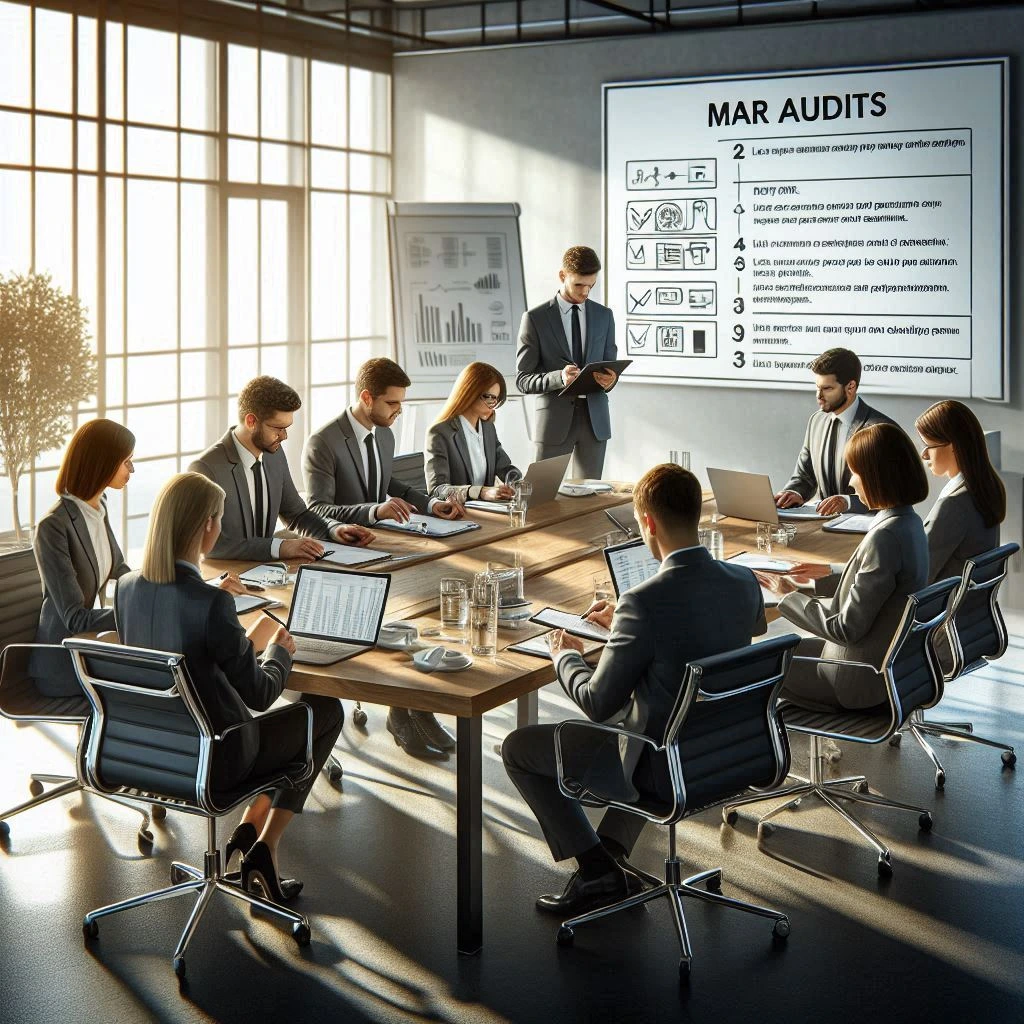Introduction to MAR Audits
In the realm of internal auditing, Model Audit Rule (MAR) audits play a crucial role in ensuring that organizations effectively identify and manage risks associated with their operations. Understanding MAR audits is essential for internal audit teams and auditors who aim to enhance their audit processes and contribute to the overall governance of their organizations.
Definition of MAR Audits
MAR audits are systematic evaluations that focus on assessing the risks that an organization faces in its operations. These audits are designed to provide an independent and objective assessment of the effectiveness of risk management processes and controls in place. By examining various aspects of the organization, including workflows, systems, and financial documents, MAR audits help ensure that risks are adequately identified and addressed [3][7].
Importance of MAR Audits in Identifying and Mitigating Risks
The significance of MAR audits cannot be overstated. They serve as a vital tool for organizations to:
- Identify Risks: MAR audits help in pinpointing potential risks that could impact the organization’s objectives, thereby enabling proactive measures to be taken.
- Mitigate Risks: By assessing the effectiveness of existing controls, MAR audits provide insights into areas that require improvement, thus helping organizations to mitigate risks before they escalate into more significant issues [4][10].
- Enhance Accountability: Conducting MAR audits fosters a culture of accountability within the organization, as it emphasizes the importance of risk management and compliance with regulatory requirements [15].
Overview of the MAR Audit Process and Its Role in Internal Audit
The MAR audit process typically involves several key steps:
- Planning: This initial phase includes defining the scope of the audit, identifying key risks, and determining the resources required for the audit.
- Fieldwork: During this phase, auditors gather data through interviews, document reviews, and observations to assess the effectiveness of risk management practices.
- Analysis: The collected data is analyzed to identify trends, weaknesses, and areas for improvement in the organization’s risk management framework.
- Reporting: Auditors compile their findings into a report that outlines the identified risks, the effectiveness of controls, and recommendations for improvement.
- Follow-Up: After the audit, it is essential to monitor the implementation of recommendations and assess their impact on risk management practices [11][12][14].
MAR audits are integral to the internal audit process, providing organizations with the necessary insights to enhance their risk management strategies. By adopting best practices in conducting MAR audits, internal audit teams can significantly contribute to the overall effectiveness and resilience of their organizations.
Understanding the MAR Audit Framework
The Model Audit Rule (MAR) is a critical regulatory framework established by the National Association of Insurance Commissioners (NAIC) that aims to enhance the governance and accountability of insurance companies. For internal audit teams and auditors, understanding the MAR audit framework is essential for executing effective audits. Below are the key components and insights into the MAR audit framework.
Components of the MAR Audit Framework
- Risk Identification: The first step in the MAR audit process involves identifying potential risks that could impact the financial reporting and operational integrity of the insurance organization. This includes assessing both internal and external factors that may pose risks to the organization’s objectives and compliance with regulatory standards [1][3].
- Risk Assessment: Once risks are identified, the next step is to evaluate the likelihood and impact of these risks. This assessment helps prioritize risks based on their significance and the potential consequences for the organization. It is crucial for auditors to utilize a systematic approach to ensure that all relevant risks are considered [10].
- Risk Response: After assessing the risks, auditors must develop appropriate responses to mitigate identified risks. This may involve implementing internal controls, enhancing governance practices, or adjusting operational strategies to align with the organization’s risk appetite. The MAR emphasizes the need for a robust framework for internal controls to ensure financial data accuracy and compliance with regulatory standards [12].
Regulatory and Compliance Requirements
The MAR establishes specific regulatory and compliance requirements that insurance companies must adhere to, particularly those exceeding certain thresholds of direct and assumed written premiums. Key requirements include:
- Auditor Independence: Ensuring that auditors maintain independence from the organization to provide unbiased assessments [14].
- Corporate Governance: Implementing strong governance practices that support accountability and transparency in financial reporting [1].
- Internal Controls over Financial Reporting (ICFR): Developing and maintaining effective internal controls to safeguard the integrity of financial data and ensure compliance with regulatory standards [12][15].
Alignment with Organizational Goals and Risk Appetite
For MAR audits to be effective, they must align with the broader organizational goals and risk appetite. This alignment ensures that the audit process supports the strategic objectives of the organization while managing risks effectively. Internal audit teams should:
– Integrate Audit Objectives with Business Goals: Ensure that the audit focuses on areas that are critical to the organization’s success and risk management strategies [3].
- Communicate with Stakeholders: Engage with key stakeholders to understand their perspectives on risk and compliance, which can inform the audit process and enhance its relevance [10][12].
- Adapt to Regulatory Changes: Stay updated with the latest regulatory changes and best practices in cybersecurity and risk management to ensure that the MAR audit remains effective and compliant [2].
By understanding these components and aligning MAR audits with organizational objectives, internal audit teams can execute effective audits that not only meet regulatory requirements but also enhance the overall governance and risk management framework of the organization.
Step 1: Planning the MAR Audit
The planning phase of a Model Audit Rule (MAR) audit is crucial for ensuring that the audit is effective and meets regulatory requirements. This phase involves several key elements that internal audit teams and auditors must carefully consider setting the foundation for a successful audit.
Establishing the Audit Scope and Objectives
- Define the Scope: Clearly outline what areas of the organization will be covered by the audit. This includes identifying specific processes, departments, or financial statements that are subject to MAR compliance. The scope should align with the regulatory requirements set forth by the National Association of Insurance Commissioners (NAIC) and should reflect the unique risks associated with the organization’s operations [2][14].
- Set Objectives: Establish clear objectives for the audit. These objectives should focus on assessing the effectiveness of internal controls over financial reporting, ensuring compliance with MAR standards, and identifying areas for improvement. Objectives should be measurable and achievable to facilitate a thorough evaluation of the audit outcomes [10][11].
Identifying Key Stakeholders and Forming the Audit Team
- Engage Stakeholders: Identify and engage key stakeholders early in the planning process. This includes senior management, the board of directors, and relevant department heads. Their input is vital for understanding the organization’s risk landscape and ensuring that the audit addresses critical areas of concern [3].
- Form the Audit Team: Assemble a skilled audit team with expertise in MAR compliance and internal controls. The team should include members with diverse backgrounds, such as finance, compliance, and risk management, to provide a comprehensive perspective on the audit process. Clearly define roles and responsibilities within the team to enhance collaboration and efficiency [1][10].
Developing an Audit Plan and Timeline
- Create an Audit Plan: Develop a detailed audit plan that outlines the methodology, resources required, and specific procedures to be followed during the audit. The plan should include a risk assessment to prioritize areas based on their significance and potential impact on financial reporting [11].
- Establish a Timeline: Set a realistic timeline for the audit, including key milestones and deadlines for each phase of the audit process. This timeline should account for the availability of resources, stakeholder input, and any regulatory deadlines that must be met. Regularly review and adjust the timeline as necessary to accommodate any changes in the audit scope or findings [10].
By meticulously planning the MAR audit, internal audit teams can ensure that they are well-prepared to conduct a thorough and effective evaluation of compliance with the Model Audit Rule. This foundational step is essential for achieving the overall objectives of the audit and enhancing the organization’s governance and accountability practices.
Step 2: Risk Assessment and Identification
Conducting a comprehensive risk assessment is a critical component of the Model Audit Rule (MAR) audit process. This step not only helps in identifying potential threats but also lays the groundwork for effective audit planning and execution. Here are some practical insights and best practices for internal audit teams and auditors to consider when performing risk assessments as part of MAR audits.
Techniques for Identifying Risks
- Interviews: Engaging with key stakeholders through structured interviews can provide valuable insights into the operational landscape and potential vulnerabilities. This method allows auditors to gather qualitative data directly from those who understand the processes and risks involved.
- Surveys: Distributing surveys to a broader audience within the organization can help capture a wide range of perspectives on risk. Surveys can be designed to assess awareness of risks and the effectiveness of existing controls, providing quantitative data that complements qualitative insights from interviews.
- Historical Data Analysis: Reviewing past incidents, audit findings, and risk assessments can reveal patterns and recurring issues. Analyzing historical data helps auditors understand which risks have materialized in the past and the effectiveness of previous mitigation strategies.
Categorizing Risks
Once risks have been identified, it is essential to categorize them to facilitate a more structured approach to risk management. Common categories include:
- Operational Risks: These are risks arising from internal processes, people, and systems. They can include issues such as system failures, human errors, and inadequate processes.
- Financial Risks: These risks pertain to the financial health of the organization, including issues related to financial reporting, fraud, and market fluctuations.
- Compliance Risks: These involve the potential for legal or regulatory penalties due to non-compliance with laws, regulations, or internal policies.
- Strategic Risks: These risks are associated with the organization’s strategic objectives and can arise from changes in the market, competition, or shifts in consumer behavior.
Utilizing Risk Assessment Matrices
To prioritize identified risks effectively, auditors can employ risk assessment matrices. These matrices help in visualizing risks based on their likelihood of occurrence and potential impact on the organization.
- Risk Matrix Framework: A typical risk matrix categorizes risks into different levels (e.g., low, medium, high) based on their assessed likelihood and impact. This visual representation aids in quickly identifying which risks require immediate attention and which can be monitored over time.
- Prioritization: By plotting risks on the matrix, auditors can focus their efforts on high-priority risks that pose the greatest threat to the organization. This targeted approach ensures that resources are allocated efficiently and effectively.
A thorough risk assessment and identification process is vital for the success of MAR audits. By employing various techniques to identify risks, categorizing them appropriately, and utilizing risk assessment matrices for prioritization, internal audit teams can enhance their audit effectiveness and contribute to the overall governance and accountability of the organization.
Step 3: Executing the MAR Audit
Executing a Model Audit Rule (MAR) audit is a critical phase that requires meticulous planning and execution to ensure compliance and enhance the overall effectiveness of the internal audit process. Here are some best practices to guide internal audit teams and auditors through this essential step:
1. Collecting Data Through Various Methods
To conduct a thorough MAR audit, it is vital to gather data using a combination of methods. This multi-faceted approach ensures a comprehensive understanding of the organization’s internal controls and financial reporting processes. Key methods include:
- Document Reviews: Examine relevant documentation such as financial statements, internal control policies, and previous audit reports. This helps auditors assess compliance with MAR requirements and identify areas needing improvement [10].
- Observations: Engage in direct observation of processes and controls in action. This allows auditors to verify that procedures are being followed as documented and to identify any discrepancies or inefficiencies [12].
- Testing: Implement testing techniques to evaluate the effectiveness of internal controls. This may involve sampling transactions to ensure they are processed accurately and in compliance with established protocols [6].
2. Maintaining Effective Communication with Stakeholders
Effective communication is crucial throughout the audit process. It fosters transparency and collaboration, which are essential for a successful audit. Best practices include:
- Regular Updates: Keep stakeholders informed about the audit’s progress, findings, and any issues that arise. This can be achieved through scheduled meetings or progress reports [11].
- Engagement: Involve key stakeholders, including management and relevant department heads, in discussions about the audit scope and objectives. Their insights can provide valuable context and facilitate smoother data collection [13].
- Feedback Mechanism: Establish a feedback loop where stakeholders can express concerns or provide additional information that may impact the audit. This encourages a collaborative environment and enhances the audit’s effectiveness.
3. Documenting Findings and Evidence Accurately
Accurate documentation of findings and evidence is essential for the integrity of the audit process. This not only supports the conclusions drawn but also serves as a reference for future audits. Best practices include:
- Detailed Records: Maintain comprehensive records of all findings, including the nature of the issue, evidence collected, and the implications for compliance with MAR. This documentation should be clear and organized to facilitate review and follow-up.
- Use of Technology: Leverage audit management software to streamline documentation processes. These tools can help in organizing findings, tracking issues, and ensuring that all evidence is easily accessible [12].
- Follow-Up Procedures: Document any follow-up actions required to address findings. This includes assigning responsibilities and setting timelines for resolution, which helps ensure accountability and continuous improvement [8].
By adhering to these best practices during the execution phase of a MAR audit, internal audit teams can enhance their effectiveness, ensure compliance with regulatory standards, and contribute to the overall governance and accountability of the organization.
Step 4: Analyzing Results and Reporting
In the context of conducting Model Audit Rule (MAR) audits, the analysis of results and the subsequent reporting are critical components that can significantly influence the effectiveness of the audit process. This step not only helps in identifying trends and insights but also ensures that the findings are communicated effectively to management and stakeholders. Here are some best practices for this phase:
Techniques for Analyzing Collected Data
- Data Segmentation: Break down the collected data into relevant categories, such as by department, process, or risk area. This allows for a more granular analysis and helps in identifying specific trends or anomalies within different segments of the organization.
- Statistical Analysis: Utilize statistical tools and techniques to analyze quantitative data. This can include trend analysis, variance analysis, and benchmarking against industry standards. Such methods can reveal patterns that may not be immediately apparent through qualitative assessments alone.
- Root Cause Analysis: For any identified issues or discrepancies, conduct a root cause analysis to understand the underlying factors contributing to these findings. This approach not only aids in addressing current issues but also helps in preventing future occurrences.
- Visualization Tools: Employ data visualization tools to create charts, graphs, and dashboards that can help in presenting complex data in an easily digestible format. Visual aids can enhance understanding and retention of the information presented.
Creating a Comprehensive Audit Report
- Structured Format: Develop a structured audit report that includes an executive summary, objectives, methodology, findings, and recommendations. This format ensures that all critical aspects of the audit are covered and easily accessible to the reader.
- Actionable Recommendations: Focus on providing actionable recommendations that are specific, measurable, achievable, relevant, and time-bound (SMART). This clarity helps management understand the steps needed to address the findings effectively.
- Prioritization of Findings: Clearly prioritize the findings based on their impact and urgency. This helps management to focus on the most critical issues first and allocate resources accordingly.
Presenting Results to Management and Stakeholders
- Clear and Concise Communication: When presenting the results, aim for clarity and conciseness. Use straightforward language and avoid jargon to ensure that all stakeholders, regardless of their technical background, can understand the findings.
- Engagement and Discussion: Encourage an interactive discussion during the presentation. This allows stakeholders to ask questions, seek clarifications, and engage in dialogue about the findings and recommendations.
- Follow-Up Actions: Conclude the presentation with a clear outline of follow-up actions, including timelines and responsible parties. This ensures accountability and helps in tracking the implementation of recommendations.
By effectively analyzing results and reporting them in a structured and engaging manner, internal audit teams can enhance the value of MAR audits. This not only aids in compliance but also contributes to the overall governance and operational efficiency of the organization, aligning with the objectives of the Model Audit Rule [10][12][14].
Step 5: Follow-Up and Continuous Improvement
In the context of conducting effective Model Audit Rule (MAR) audits, the follow-up process is crucial for ensuring that the recommendations made during the audit are implemented and that the organization continues to improve its internal controls and risk management practices. Here are some best practices for executing this step effectively:
- Developing a Follow-Up Plan: It is essential to create a structured follow-up plan that outlines how the implementation of audit recommendations will be tracked. This plan should include specific timelines, responsible parties, and measurable outcomes to ensure accountability. Regular follow-up audits should be conducted to verify that improvements are sustained and to identify any new areas for enhancement [13].
- Encouraging Feedback from Stakeholders: Engaging stakeholders in the follow-up process is vital. By soliciting feedback from those affected by the audit findings, internal audit teams can gain valuable insights into the effectiveness of the recommendations and the challenges faced during implementation. This feedback loop not only helps in refining future audits but also fosters a collaborative environment where stakeholders feel valued and involved in the improvement process [2][5].
- Establishing a Culture of Continuous Improvement: To truly embed continuous improvement within the organization, it is important to cultivate a culture that prioritizes ongoing risk management practices. This involves training staff on the importance of internal controls, encouraging open communication about risks, and recognizing efforts to improve processes. By promoting a mindset of continuous improvement, organizations can better adapt to changes and enhance their overall governance and accountability [13].
The follow-up and continuous improvement phase of MAR audits is not merely a procedural step; it is a fundamental aspect of ensuring that the audit process leads to meaningful enhancements in organizational practices. By developing a robust follow-up plan, encouraging stakeholder feedback, and fostering a culture of continuous improvement, internal audit teams can significantly contribute to the long-term success and resilience of their organizations.
Conclusion
In summary, conducting effective Model Audit Rule (MAR) audits is essential for ensuring compliance and enhancing the integrity of financial reporting within the insurance industry. By following a structured, step-by-step approach, internal audit teams can significantly improve their audit processes and outcomes. Here are the key takeaways:
- Recap of the Step-by-Step Approach: The process of executing MAR audits involves several critical steps, including understanding the regulatory requirements, establishing robust internal controls, conducting thorough risk assessments, and implementing continuous monitoring practices. Each of these steps is designed to ensure that financial data is accurate and compliant with regulatory standards, ultimately enhancing operational efficiency and mitigating risks [1][11].
- Encouragement for Internal Audit Teams: It is vital for internal audit teams to adopt these best practices consistently. By doing so, they not only uphold the standards set forth by the National Association of Insurance Commissioners (NAIC) but also contribute to the overall governance and accountability of their organizations. Emphasizing the establishment of internal audit functions and risk management processes will further strengthen the financial integrity of healthcare insurers and other entities subject to MAR [2][3].
- Call to Action for Auditors: Auditors are encouraged to prioritize MAR audits within their overall audit strategy. Given the complexities and regulatory demands associated with MAR compliance, dedicating resources and attention to these audits will ensure that organizations remain compliant and can effectively navigate the evolving landscape of financial reporting [12][15]. By making MAR audits a focal point, auditors can enhance their value proposition and support their organizations in achieving long-term success.
In conclusion, the implementation of best practices in MAR audits is not just a regulatory requirement; it is a strategic imperative that can lead to improved financial reporting, enhanced transparency, and greater stakeholder confidence. Internal audit teams and auditors must commit to these practices to foster a culture of compliance and excellence within their organizations.
Find out more about Shaun Stoltz https://www.shaunstoltz.com/about/
This post was written by an AI and reviewed/edited by a human.



